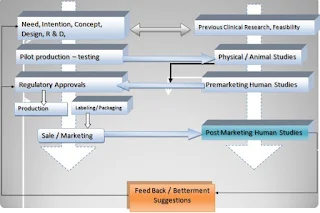With recent times INDIA is booming as developing place for all the fields along with Clinical Research. Because of the large population and diversity India is one of the hot spot for clinical research at the global frontier. The population across country understanding the real health care need and the importance of drug discovery where the critical link is Clinical Research.
Clinical Development is the key milestone for a drug to get into the market shelf. Clinical Studies got vital role for better understanding of the discovered molecule activity in human and the subjects who are intended consumers of the drug.
For a successful drug launch the Clinical Studies and population participation is a demanding process which should happen for achieving the objectives of the drug utility and to provide best health care to save lives.
The connectivity of process and the prominent points of patient recruitment and retention;
· Clinical development phase initiation
· Clinical Trials protocols development
· Therapeutic Indications understanding
· Patient availability & assessments
· Patient recruitment and retention strategies
Patients Availability and Assessments – The study design and the indications were the base to engage and assess the patients availability and assessments must be done on the basis of:
o Ethnicity
o Demographics
o Geographic
o Behavioral
o Psychographic
o Incidence and Prevalence
o Epidemiology
Advertising programs brings attention about the research happening and ignites intentions for connecting population to participate in the research. The healthier and understandable advertising with proper methodologies really brings branding for the drug as well. Across globe the concept of medical research and the potential risks and benefits has to be socially publicized through media by having regulatory intimacy.
The consistent advancements through ethical research for establishing bliss for humanity through medicines and participated population and the benefits received by them by value and appreciation must be taken forward into society and public by media. These kinds of steps will enhance awareness across communities for contributing into research and development.
Patient retention throughout the study is the most important task and it can be achieved by the classic methodologies and the intimacy of Investigator and site team plays vital role to achieve maximum retention rate.
Patient retention is possible with; GENELIFE CLINICAL RESEARCH methodology
· Simple explanation of the study and the milestones of it
· Clear and complete understanding about the patient importance and expectation from them
· Explaining the potential benefits risks and facts about the study and their role with intimacy in terms of health, reimbursements (travel & meal) and making patient comfortable at clinic
· Whom to contact if patient is having any questions or concerns and being available at any time accessible for patients.
· Make patient clear about quit procedures and its implications and results.
· Make them feel appreciated and valued as they were critical contributors for the research
· Consistent interaction with patients and follow up.
Patient recruitment is possible with; GENELIFE CLINICAL RESEARCH methodology.
Focus groups- the population eligible for study participation. Identifying focus groups and finding the communities through available data resources.
· Communicating and engaging different critical disease communities across the globe by accessing the GP’s and various organization and independent disease surveys making GENELIFE CLINICAL RESEARCH potential with subject availability.
· The DSR – Disease Surveillance Reports across different horizons with floating life standards and various conditions based survey is making GENELIFE CLINICAL RESEARCH understand the proximities of disease prevalence.
· Building extensive relationships with research organizations, institutions, academic labs, hospitals, clinics and medical fraternity with ethical research oriented intention is paving way to access patient pool for desires indications across therapeutic indications.
These steps improving the Clinical research employing potential, to move on with best patient recruitment and retention strategies for accomplishing the study primitives.
GENELIFE CLINICAL RESEARCH employs such methodologies with global outreach to provide compendious clinical development solutions
Regards,
GENELIFE CLINICAL RESEARCH








